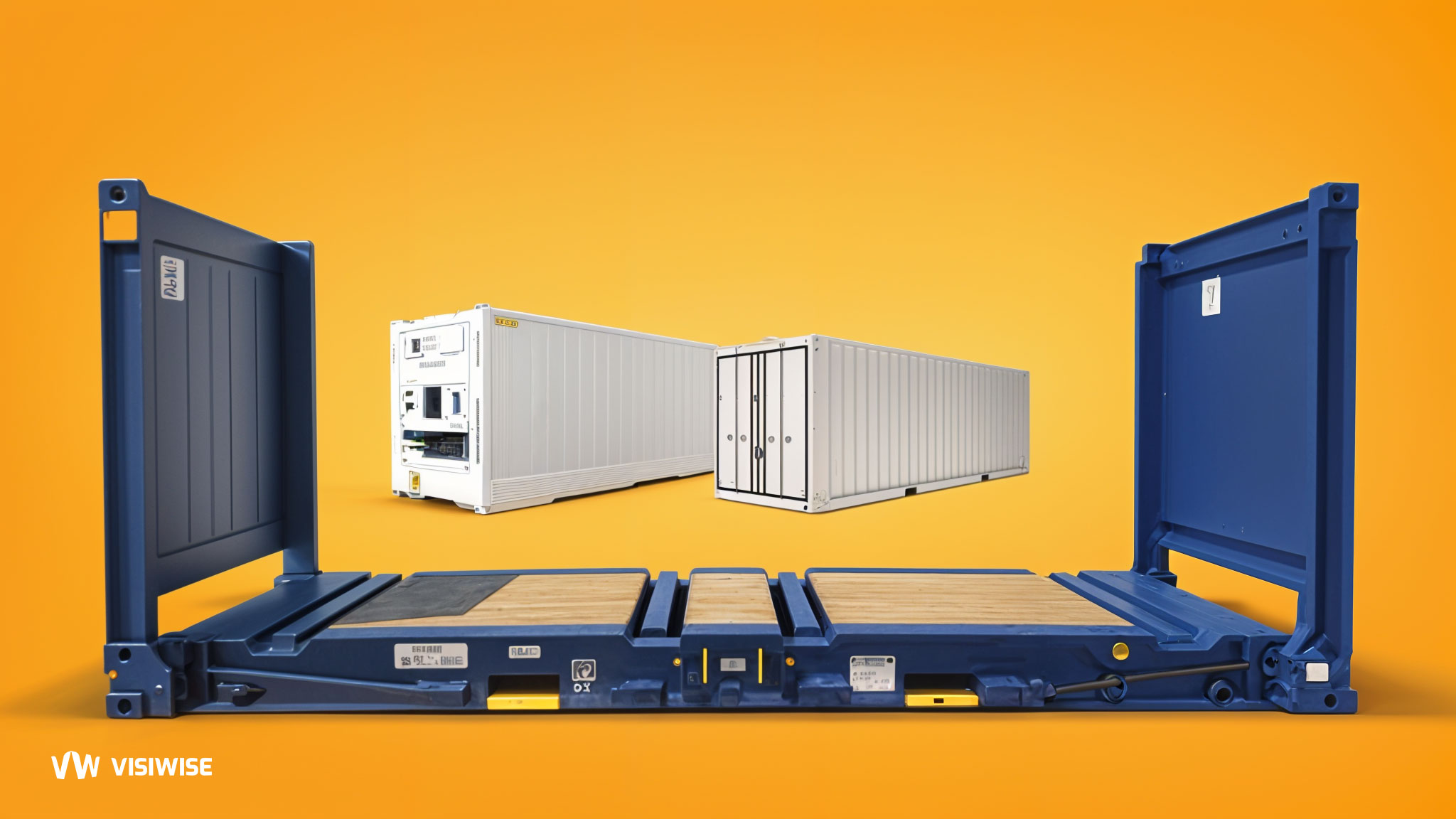Shipping containers have revolutionized global trade and transportation since their inception in the mid-20th century. These standardized, durable steel boxes come in various types, each designed to meet specific cargo needs and transportation requirements. From standard dry containers to specialized reefers and flat racks, the diversity in shipping container types enables the efficient movement of goods across vast distances, both by sea and land. Understanding the characteristics and purposes of different container types is crucial for optimizing logistics operations and ensuring the safe delivery of diverse cargo. In this introduction, we’ll explore the various types of shipping containers commonly used in international trade and transport, highlighting their unique features and applications in today’s interconnected global economy.
1) 10’, 20’, and 40’ Dry Storage Containers
Dry storage containers are the backbone of global shipping, offering a versatile solution for transporting a wide range of dry goods, from clothing and electronics to machinery and raw materials. Available in three standard sizes – 10 feet, 20 feet, and 40 feet – these containers cater to various cargo volumes and transportation needs.
10-Foot Dry Storage Containers: While less common than their larger counterparts, 10-foot dry storage containers provide a compact and cost-effective solution for shipping smaller loads or when space is limited. They are often utilized for transporting specialty goods, such as high-value electronics, pharmaceuticals, or perishable items requiring climate-controlled conditions.
20-Foot Dry Storage Containers: The 20-foot dry storage container is the most widely used size in the shipping industry. Its moderate size strikes a balance between capacity and maneuverability, making it ideal for transporting goods of varying sizes and volumes. From consumer goods and automotive parts to furniture and household appliances, these containers accommodate a diverse array of cargo, both in terms of weight and dimensions.
40-Foot Dry Storage Containers: For larger shipments or bulkier cargo, the 40-foot dry storage container offers ample space and efficiency. With double the capacity of a 20-foot container, it is commonly used for transporting heavy machinery, industrial equipment, and oversized items. Its standardized dimensions ensure compatibility with various transportation modes, including ships, trains, and trucks, facilitating seamless intermodal logistics.
Versatility and Standardization: Despite differences in size, all dry storage containers share standardized dimensions and construction, allowing for easy stacking, handling, and transportation. Their durable steel construction and weather-resistant design protect goods from moisture, theft, and environmental factors during transit, ensuring the integrity and security of shipments across vast distances and diverse climates.
In essence, 10-foot, 20-foot, and 40-foot dry storage containers form the cornerstone of modern logistics, providing a reliable and efficient means of transporting goods worldwide. Their adaptability and standardized design make them indispensable assets in the global supply chain, facilitating the smooth flow of trade and commerce across borders.
2) Flat Rack Containers
Flat rack containers are specialized shipping containers with collapsible sides, allowing for easy loading and unloading of oversized or irregularly shaped cargo. They lack side walls and a roof, providing flexibility for transporting goods such as machinery, vehicles, and large industrial equipment. Flat rack containers come in various sizes and configurations, including 20-foot and 40-foot options, with some featuring fixed or collapsible ends to secure cargo during transit. Their versatility makes them ideal for transporting bulky items that cannot fit into standard dry containers, offering a practical solution for handling diverse and challenging cargo requirements.
3) Open-top Containers
Open-top containers are specialized shipping units designed for cargo that exceeds the height limitations of standard containers or requires top-loading. Unlike traditional containers, they lack a fixed roof, allowing for easy access to load or unload goods from the top. These containers feature removable tarpaulin covers or a convertible roof structure, providing protection from weather elements while accommodating oversized or bulky items such as machinery, pipes, or construction materials. Open-top containers are commonly used in industries like construction, mining, and manufacturing, where the transportation of large, heavy, or irregularly shaped cargo is common. Their versatility and accessibility make them an essential asset in logistics operations, facilitating the efficient movement of goods across various modes of transportation, including ships, trains, and trucks.
4) Tunnel Containers
Tunnel containers, also known as double-door containers, are a specialized type of shipping container featuring doors at both ends. This unique design allows for convenient access to the container’s interior from either side, facilitating efficient loading and unloading of cargo. Tunnel containers are particularly useful in situations where goods need to be accessed from both ends or when items are stored in a manner that requires access from either side. They offer flexibility in logistics operations, enabling faster turnaround times and streamlined processes during transportation and warehousing. Common applications of tunnel containers include transporting perishable goods, such as fruits and vegetables, where rapid loading and unloading are crucial to maintaining product freshness. Additionally, they are utilized in construction projects for storing and transporting building materials and equipment, optimizing workflow efficiency on job sites. Overall, tunnel containers play a valuable role in enhancing logistics operations by providing versatile and accessible storage solutions for various cargo types.
5) Open-side Storage Containers
Open-side storage containers, also known as side-opening containers, are a specialized type of shipping container distinguished by their full-length side doors. Unlike standard containers, which typically only have doors at one end, open-side containers feature doors that span the entire length of one or both sides, providing convenient access to the container’s interior. This design facilitates easy loading and unloading of cargo, especially items that are long, bulky, or difficult to maneuver. Open-side containers are ideal for storing and transporting goods such as lumber, piping, machinery, and oversized equipment. They are also commonly used in industries requiring quick and efficient access to stored items, such as construction, events management, and disaster relief. The versatility and accessibility offered by open-side storage containers make them a valuable asset in logistics operations, enabling seamless handling of diverse cargo requirements and optimizing workflow efficiency.
6) Insulated and Thermal Containers
Insulated and thermal containers are specialized shipping units designed to maintain consistent temperature levels, protecting temperature-sensitive cargo during transportation. These containers feature insulation materials and thermal barriers that minimize heat exchange with the external environment, ensuring that goods remain within specified temperature ranges. Commonly used in industries such as pharmaceuticals, food and beverage, and chemicals, insulated and thermal containers safeguard perishable items, pharmaceuticals, and other sensitive products from temperature fluctuations that could compromise their quality or efficacy. By providing a controlled environment, these containers help preserve the integrity of the cargo throughout its journey, from origin to destination, ensuring compliance with regulatory requirements and meeting customer expectations for product quality and safety.
7) ISO Tank and Flexitank Containers
ISO tank containers and flexitank containers serve distinct purposes in the transportation of liquids. ISO tank containers are rigid, cylindrical tanks built to ISO standards, typically made of stainless steel. They’re robust, durable, and suitable for transporting various liquids, chemicals, and gasses in bulk. ISO tanks offer security, cleanliness, and versatility, as they can be transported via multiple modes of transportation and easily handled by standard container equipment.
Flexitank containers, however, are flexible, collapsible containers made from multilayered materials like polyethylene or polypropylene. They’re designed to fit inside standard 20-foot shipping containers, converting them into bulk liquid transportation units. Flexitanks are cost-effective for non-hazardous liquids like wine, fruit juices, and edible oils, offering a single-use solution without the need for cleaning and return shipping.
Both containers cater to specific needs in the logistics industry, with ISO tanks suitable for hazardous materials and flexitanks ideal for non-hazardous liquids, providing options for efficient liquid transport across various industries.
8) Double-door Containers
Double-door containers, as the name suggests, feature doors at both ends, providing convenient access from either side. This design facilitates efficient loading and unloading of cargo, especially for items requiring access from both ends or stored in a manner that necessitates access from either side. These containers enhance logistics operations by streamlining processes and reducing turnaround times during transportation and warehousing. They find applications in various industries, including construction, manufacturing, and agriculture, where rapid access to stored goods is essential for maintaining workflow efficiency. Overall, double-door containers provide a practical solution for handling diverse cargo requirements in logistics and transportation.
9) Refrigerated ISO Containers
Refrigerated ISO containers, commonly referred to as reefer containers, are specially designed shipping units equipped with built-in refrigeration systems. These containers maintain precise temperature control, ensuring the safe transportation of temperature-sensitive goods such as food, pharmaceuticals, and chemicals. Reefer containers feature insulation and advanced refrigeration technology, allowing them to maintain consistent temperature levels regardless of external conditions. They are available in various sizes, conforming to ISO standards, and are compatible with standard container handling equipment. Reefer containers play a critical role in the cold chain logistics industry, preserving the quality and integrity of perishable goods throughout the supply chain. Their versatility and reliability make them indispensable for transporting goods across long distances by sea, land, and rail, meeting stringent quality and safety standards while ensuring the freshness and shelf-life of sensitive products.
10) Special-purpose Containers
Special-purpose containers encompass a wide range of containers tailored to specific cargo needs. They come in various shapes and sizes, often custom-made to accommodate unique goods or transportation requirements. Examples include flat racks for oversized items, open-top containers for easy loading of bulky goods, and tank containers for liquids and gases. These containers cater to specialized industries like construction, agriculture, and chemical transportation, providing tailored solutions for efficiently transporting diverse cargo types. With their custom designs and specialized features, special-purpose containers play a vital role in optimizing logistics operations and meeting the unique demands of various industries.
11) Swap Bodies
Swap bodies are intermodal containers designed for seamless transfer between truck chassis and railcars. They feature foldable legs that support the container during transportation shifts. Lighter and more cost-effective than standard shipping containers, swap bodies are popular in Europe for their versatility and efficiency in multimodal logistics. This flexibility streamlines cargo transport, reducing handling time and costs. Swap bodies accommodate various goods and are integral to Europe’s intermodal transportation network, enhancing supply chain efficiency and sustainability.
12) Half-height Containers
Half-height containers are specialized shipping units with reduced height, typically half the size of standard containers. They are designed to transport heavy or dense cargo that requires lower center of gravity for stability. Commonly used for commodities like coal, ores, and other bulk materials, these containers offer efficient loading and unloading through their reduced height. They provide a secure and space-efficient solution for transporting dense goods, optimizing container capacity while ensuring safe transportation. Half-height containers are commonly found in industries such as mining, construction, and agriculture, where the transportation of heavy materials is prevalent. Their specialized design enhances logistics operations, facilitating the movement of dense cargo across various modes of transportation.
13) Car Carriers containers
Car carriers are specialized container storage units designed for long-distance transportation of vehicles. Featuring collapsible sides, these containers provide a secure fit for cars, preventing movement and potential damage during transit. The collapsible sides ensure that the vehicles remain snugly in place throughout the journey, minimizing the risk of shifting or impacts. Car carriers are essential in the automotive industry for transporting vehicles efficiently and safely, whether for domestic distribution or international shipping. Their design enhances cargo protection, reducing the likelihood of damage during transportation, and contributes to the smooth flow of vehicles within the global supply chain.
14) Drums
Drums, cylindrical shipping containers made from steel, plastic, or fiber, excel in transporting liquids and granular materials securely. Often used for hazardous substances, they ensure safe shipment, mitigating spillage risks. Drums are vital in industries like chemicals and pharmaceuticals, offering reliable containment and compliance with safety regulations.
15) Intermediate bulk shift containers
Intermediate bulk shift containers are specialized shipping units designed for the intermediate transportation of goods. They’re tailored to handle large quantities of materials, facilitating the transfer of goods to destinations where further packing and shipment to the final destination occur. These containers optimize logistics by efficiently transporting bulk materials, reducing handling and transfer time. Their design ensures safe and secure transportation of goods, making them essential in industries requiring intermediate storage and distribution, such as manufacturing, logistics, and warehousing. Intermediate bulk shift containers streamline supply chain operations, enabling seamless movement of materials from production facilities to distribution centers and beyond.



